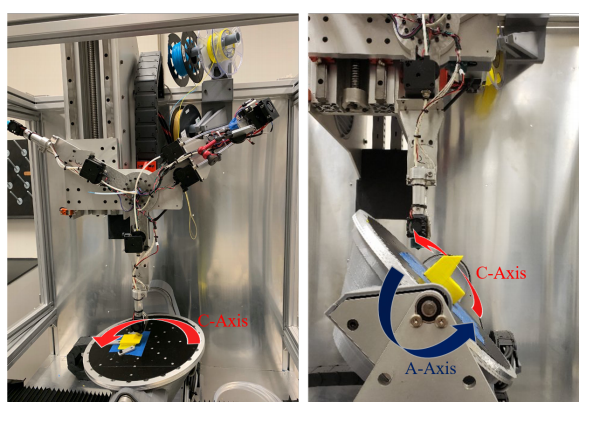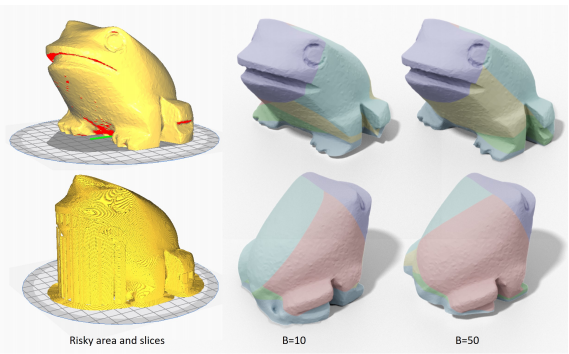International researchers investigate more complex matters in digital fabrication, detailing their latest study in the recently published ‘Learning to Accelerate Decomposition for Multi-Directional 3D Printing.’ Delving into a subject of great interest for most users interested in creating complex geometries, the authors explain more about recent work designed to use a beam-guided search algorithm to find an optimized sequence of plane-clipping resulting in the need for ‘tremendously less supports.’ In some cases, no supports may be required at all.

A 5-DOF multi-directional 3D printing system that can deposit material along different directions: (left) the printer head can move along x−, y− and z−axes and (right) the working table can rotate around two axes (see the arrows for the illustration of A-axis and C-axis).
Planar layers with fixed 3D printing direction usually require supports to prevent collapse; however, this added material can be a source of major hassle for even the most experienced users. To solve the problem in requiring supports, the research team created a new algorithm meant to decompose models into sub-components being printed separately in different directions for different components.
“The benefit of the proposed search algorithm is that it can avoid being stuck in local minimum compared to greedily searching the best result. Beam width b = 10 is empirically used to balance the trade-off between computational efficiency and searching effectiveness,” explained the authors. “Though conducting a parallel implementation running on a computer with Intel(R) Core(TM) i7 CPU (4 cores), the method still results in an average computing time of 6 minutes.”

For a given model (ID: 81368 from the Thingi10k dataset [3]) need large amount of support structures by conventional 3D printing (left), multi-directional 3D printing can significantly reduced the need of support. While increasing the beam width from B = 10 (middle) to B = 50 (right), the area of region needs to add support can be reduced from 17.34% to 2.64%.
“The proposed method utilizes a learning-based method to train a decision-tree-based ensemble that can score the candidates of clipping,” explained the researchers.

A sequence of multi-directional 3D printing can be determined by computing a sequence of planar clipping (left), where the inverse order of clipping gives the sequence of multi-directional 3D printing (right).
Accessibility is key in this new system, with the model and the source codes all available to the public. A high-performance server is used with two Intel E5- 2698 v3 CPUs and 128 GB RAM, with all other tests employing an Intel Core i7 4790 CPU, NVIDIA Geforce GTX 980 Ti GPU and 24 GB RAM.
“We trained our model on the Thingi10k dataset repaired by Hu et al. Instead of training and evaluating on the whole dataset, we extract a subset of the dataset (2061 models) that satisfies every model in the selected dataset should have a few risky faces that can be processed by our plane-based cutting algorithm,” concluded the researchers.
“The computing time is reduced to 1/2 while keeping the results with similar quality. The experimental results demonstrate the effectiveness of our proposed method. We provide an easy-to-use python package and make the source code publicly accessible.”
Requirements for supports tend to be a source of consternation for users, leaving scientists to investigate the use of robotics to help eliminate support materials, exploring materials like resin, and improving ongoing work with material like water-soluble supports. What do you think of this news? Let us know your thoughts; join the discussion of this and other 3D printing topics at 3DPrintBoard.com.
[Source / Images: ‘Learning to Accelerate Decomposition for Multi-Directional 3D Printing’]Subscribe to Our Email Newsletter
Stay up-to-date on all the latest news from the 3D printing industry and receive information and offers from third party vendors.
Print Services
Upload your 3D Models and get them printed quickly and efficiently.
You May Also Like
Making 3D Printing Personal: How Faraz Faruqi Is Rethinking Digital Design at MIT CSAIL
What if your 3D printer could think more like an intelligent assistant, able to reason through a design idea, ask questions, and deliver something that works exactly the way the...
Reinventing Reindustrialization: Why NAVWAR Project Manager Spencer Koroly Invented a Made-in-America 3D Printer
It has become virtually impossible to regularly follow additive manufacturing (AM) industry news and not stumble across the term “defense industrial base” (DIB), a concept encompassing all the many diverse...
Heating Up: 3D Systems’ Scott Green Discusses 3D Printing’s Potential in the Data Center Industry
The relentless rise of NVIDIA, the steadily increasing pledges of major private and public investments in national infrastructure projects around the world, and the general cultural obsession with AI have...
Formlabs Teams Up with DMG MORI in Japan
In late June, Nick Graham, Chief Revenue Officer at Formlabs, announced on LinkedIn that the company had partnered with DMG MORI, one of the world’s leading machine tool companies, to...

































